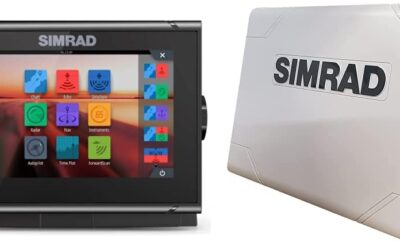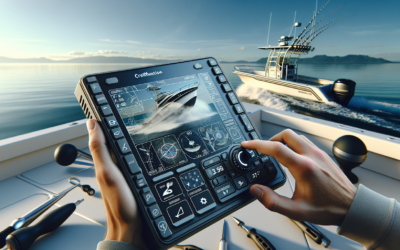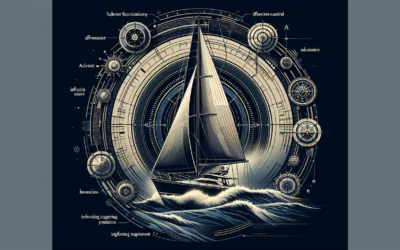If you’ve ever been intrigued by the intriguing world of aquatic life, then “Interpreting Arch Shapes: Understanding Fish Size and Movement on the Screen” is just the read you need. This comprehensive guide unravels the mystery behind how the shape of an arch on a screen can help determine the size and movement of fish. Filled with insightful explanations, it helps to decode the visual complex patterns and cues, translating them into recognisable data about the size and motion of these intriguing marine creatures. Be ready to broaden your understanding and deepen your appreciation of the underwater world!.
Understanding The Basics of Fish Finders
Before diving into the complexities of arch shapes on a fish finder screen, let’s first understand the device’s fundamentals. Fish finders are handheld or boat-mounted devices widely used in angling and commercial fishing to scan and visualize what lies beneath the water surface.
How fish finders work
Fish finders work using SONAR technology – Sound Navigation and Ranging. The device emits sound waves that hit objects underwater and reflect back to the finder. The returning signal’s time and strength are then analyzed to determine the object’s location and size.
Types of fish finders
There are several types of fish finders available in the market, and each serves a unique purpose. Standalone fish finders are suitable for beginners and smaller boats, whereas combination finders are integrated with GPS for advanced navigation. Networked fish finders offer the most sophisticated technology, combining navigation, radar, and even video streaming.
Importance of fish finders for fishing
Fish finders play an essential role in elevating your fishing experience. They not only detect fish but also help identify underwater structures, contours, and vegetation that could be potential fish harbors. By providing real-time under-water visualization, fish finders significantly make fishing more effective and efficient.
Explaining Arch Shapes on the Screen
Interpreting the information displayed on the fish finder screen, particularly the arch shapes, is key to understanding the underwater world better.
What arch shapes represent
The arch shapes on the fish finder’s screen represent fish that have swum within the cone of the fish finder’s sonar beam. The arch’s appearance, length, and fullness offer insights into the fish size, distance from the sonar, fish’s movement, and even the fished depth.
Why arch shapes vary
You might wonder why the arch shapes on the screen vary. The variations in the arch shapes depend on several factors, such as the fish’s size, its distance from the sonar, depth, and the fish’s movement relative to the sonar beam.
How arch shapes inform about fish behavior
Fish movements can dramatically impact the appearance of the arch shapes on the display. If a fish is stationary or moving slowly within the beam’s range, the arch formed is more extended and fuller. In contrast, a quickly moving fish may cause the arch to be narrow or broken.
Correlation between Arch Size and Fish Size
The size of the arch on the screen generally indicates the fish’s size. However, various factors could affect this interpretation.
Interpreting fish sizes from arch shapes
Typically, a bigger arch indicates a larger fish, while a small arch implies a smaller fish. Remember, though, that the fish’s size is not the only determinant of arch size.
Factors that affect arch sizes
While interpreting the arch sizes, it’s important to consider other factors like fish’s depth, distance from the sonar, and movement speed because they also influence the arch’s appearance.
How to accurately judge fish size from arches
To accurately judge the fish size from the arch size, you need to have a good understanding of the above factors and practice reading different signals. You might also want to experiment with different sensitivity settings on your fish finder for better accuracy.
Deciphering Fish Movement Through Arch Shapes
The fish movement has a significant impact on the arch shapes represented on the fish finder’s screen.
How fish movement affect arch shapes
As the fish moves, its distance from the sonar changes, which in turn affects the sonar return’s time and intensity. So, staying still or moving slowly within the beam’s range results in a fuller and longer arch, whereas a fast-moving fish creates a narrower or broken arch.
Interpreting different fish movements using arches
By examining the length, fullness, and continuity of an arch, you can interpret if the fish is stationary, moving slowly, or fast. This information can be instrumental in predicting fish behavior and planning your fishing strategy.
Effects of fish movements on arch signals
Fish movements directly affect the arch signals in terms of their strength and continuity. Closer and slower-moving fish result in stronger and more consistent signals, while distant and fast-moving fish can cause weaker and discontinuous signals.
Influence of Depth and Distance on Arch Shapes
Understanding how depth and distance influence the arch shapes on the screen can significantly enhance your fish finder reading skills.
Effects of fish depth on arch shapes
The depth at which a fish is swimming can greatly impact the arch shape. Fish at greater depths generally create longer arches as they stay within the sonar cone for a longer time.
How fish distance from the sonar affects the arch size
The distance of the fish from the sonar also affects the arch shape. A fish located directly under the sonar (closer) will form a fuller arch while one located away (farther) will form a narrower arch.
Balancing depth and distance for accurate interpretation
Accurately interpreting arch shapes requires balancing and understanding how depth and fish distance influence the sonar signals. This skill comes with patience, experience, and continuous exploration of your fish finder device.
Interpreting Multiple Fish Indications
Identifying multiple fish indications on fish finder screen can be a bit challenging but not impossible.
How multiple fish appear on the screen
When multiple fish swim within the sonar’s beam range, multiple arches, possibly overlapping, appear on the screen.
Differentiating between fish shoals and single fish
Identifying fish shoals and a single fish require keen observation of the screen. Dense clusters of arches might indicate the presence of fish shoals, while single and separate arches usually indicate isolated fishes.
Managing overlaps in arch signals
Interpreting overlapping arch signals could be tricky. With practice and a better understanding of how different factors affect arch shapes, you can better manage overlapping signals and differentiate between them.
Detecting Fish Species through Arch Shapes
While it’s challenging to identify fish species through arch shapes, some experienced anglers might achieve it.
Can specific fish species be identified through arch shapes?
It’s primarily challenging to identify specific fish species through arch shapes as different species, varying in size and behavior, can create similar arch shapes.
Variables that complicate fish species identification
Many variables, such as depth, distance, fish movement, and environmental factors, complicate fish species identification through arch shapes on the screen.
Tips for possible species detection from arches
Species detection through arch shapes might be possible based on local knowledge about the size, behavior, and habitat of specific species combined with careful examination of arch shapes, sizes, and patterns.
Impacts of Environmental Factors on Arch Shapes
Various environmental factors can considerably impact the arch shapes on the fish finder screen.
Effects of water temperature and salinity on arch shapes
Water conditions like temperature and salinity can affect sonar signals and subsequently the arch shapes. For instance, colder and saltier water can cause the sound waves to travel faster, which might affect the arch appearance on the screen.
Influence of water currents and tides on arch signals
Water currents and tides cause water movement, which can move the fish and change its distance and position relative to the sonar, hence affecting the arch signals.
Role of underwater structures and vegetation
Underwater structures and vegetation can reflect the sonar signals and cause clutter and noise on the screen, thus impacting the appearance of arch shapes.
Troubleshooting and Resolving Arch Shape Interpretation Issues
Interpreting arch shapes in fish finders can sometimes be challenging but knowing and addressing common issues can make things easier.
Common problems in interpreting arch shapes
Some common problems encountered while interpreting arch shapes include distinguishing between fish and other underwater objects, dealing with overlapping arches, and inaccuracies due to changing environmental conditions.
Potential solutions for arch shape interpretation problems
Experimenting with different settings of the fish finder, understanding local water bodies and fish behavior, and gaining hands-on experience over time can help resolve most of the common arch interpretation issues.
Avoiding misinterpretation of arch signals
Being aware of the factors affecting the accuracy of arch signals and careful observation will help avoid misinterpretation. Also, it’s essential to remember that the fish finder is just a tool to aid in fishing, and practical experience and intuition play a significant role in success.
Advancements and Technological Innovations in Arch Shape Interpretation
Technology plays a critical role in enhancing the utility and accuracy of fish finders.
How technology is aiding in arch shape interpretation
Modern fish finders come with enhanced sonar technologies and software algorithms that aid in better arch shape generation and interpretation, leading to a higher success rate in fishing.
Current advancements in fish finder technology
Current advancements in fish finder technology involve high-resolution screens, multiple sonar frequencies, GPS integration, and Wi-Fi connectivity. These advancements offer clearer images and more accurate detection of fish and other underwater objects.
Future trends in fish finder and arch interpretation technology
In the future, we can expect fish finders to have advanced features like 3D imaging, Artificial Intelligence-enabled species identification, and more precise depth and distance estimations.
In conclusion, understanding and interpreting arch shapes on the fish finder screen, considering all the influencing factors, can dramatically improve your fishing experience and yield. So, happy fishing and make the best out of your fish finder!









